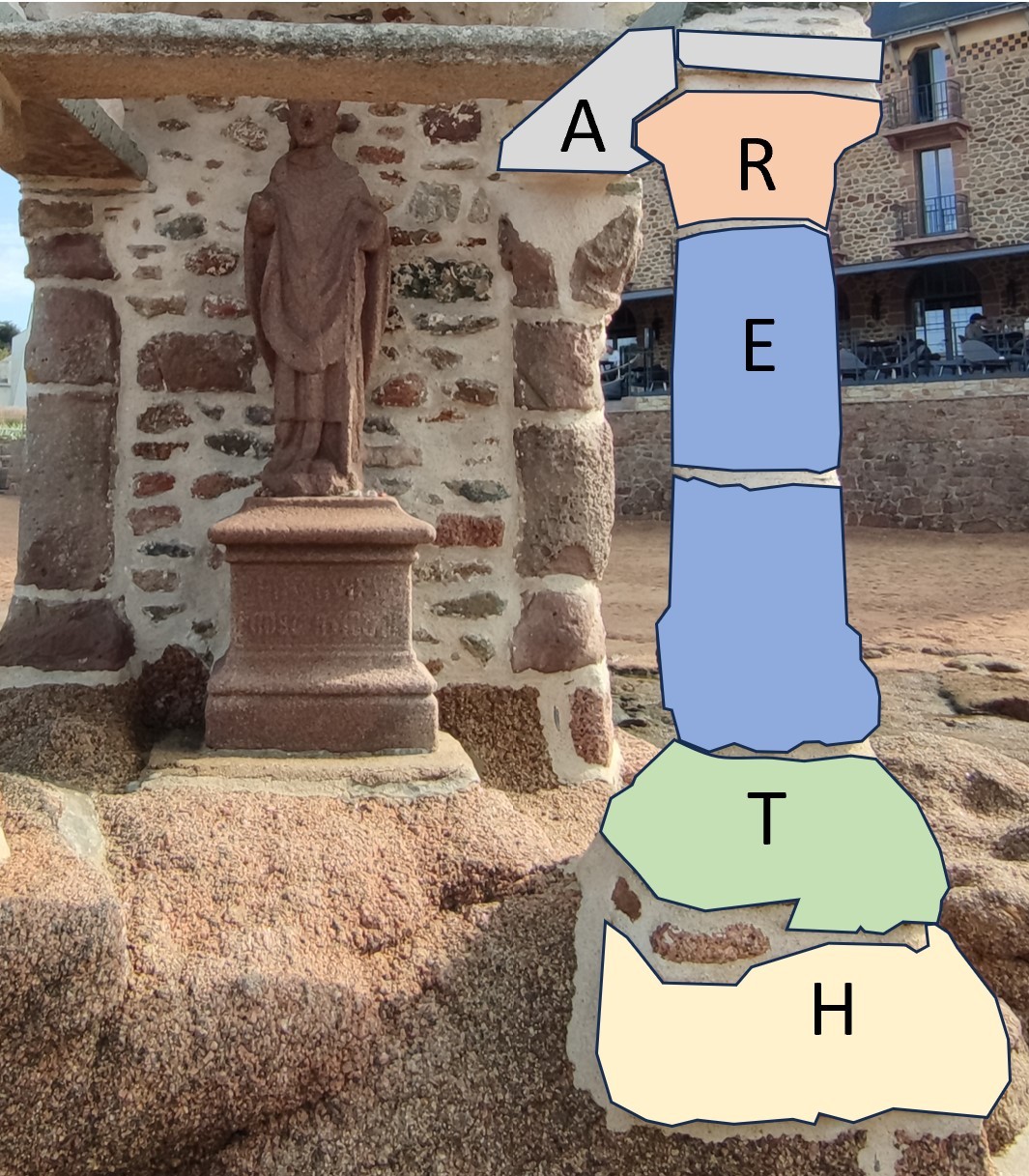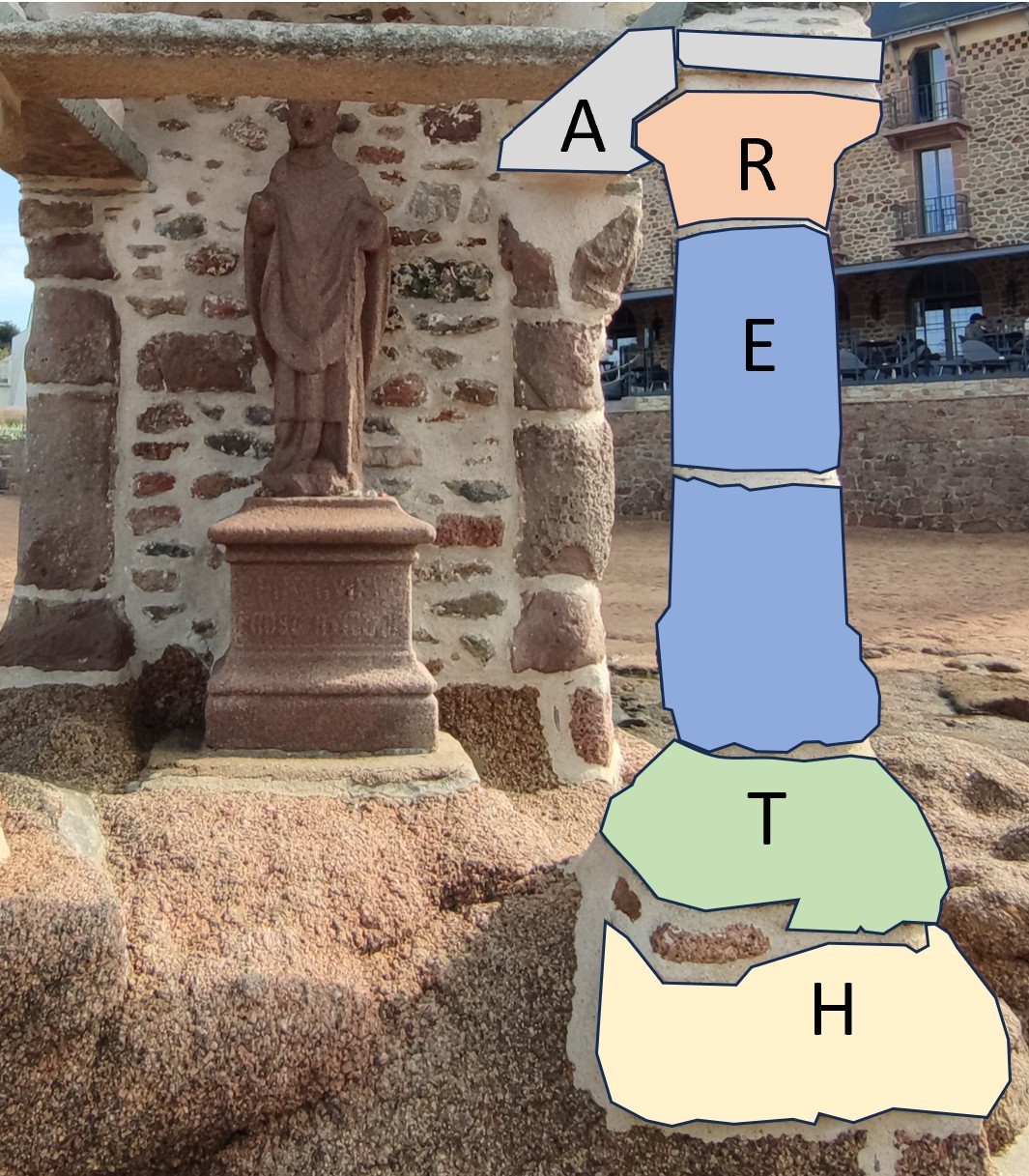English listing below / deutsches Listing below
En cas de marée haute, la cache n'est accessible qu'à la nage. Merci de faire attention lorsque vous visitez cette cache.
La taille des cristaux dans le granite
Qu'est-ce que le granite ?
Le granite est une roche plutonique, c'est-à-dire une roche qui s'est solidifiée loin sous la surface de la terre. Dans ce contexte, la composition de la masse fondue et la vitesse de refroidissement peuvent fortement influencer l'aspect de la roche en formation.
Les éléments constitutifs du granite
Le granite se compose généralement de trois groupes de minéraux, le feldspath, le quartz et le mica, qui contribuent de différentes manières aux propriétés du granite. On peut dire que les feldspaths donnent au granite sa couleur, le quartz son éclat et les micas ses veines.
Formation de cristaux lors de la solidification
Lorsque les roches en fusion se solidifient, elles forment des cristaux que l'on peut parfois très bien voir à l'œil nu et que l'on doit parfois regarder de très près pour les distinguer. Cela dépend beaucoup de la vitesse à laquelle la masse fondue se solidifie. Si le processus est rapide, les différents minéraux ont peu de temps pour former les cristaux et ils restent très petits. Mais si le refroidissement est très lent, les cristaux peuvent atteindre une taille considérable. Un exemple de refroidissement très lent est le pluton McKinley, pour lequel un taux de refroidissement de 4-10 kelvins par 1.000.000 d'années a été déterminé ! [1] Il est également possible que le refroidissement soit d'abord rapide, puis plus lent, ou l'inverse.
Les minéraux du granite ont des points de fusion différents, ce qui fait qu'ils se solidifient les uns après les autres lors du refroidissement. Ce sont les micas qui se solidifient en premier, car ils ont les points de fusion les plus élevés. C'est pourquoi ils ne peuvent normalement former que de petits cristaux, car le refroidissement à haute température est généralement assez rapide. Ensuite, ce sont les feldspaths qui se solidifient et qui peuvent former de plus grands cristaux, et enfin le quartz qui se solidifie et qui remplit surtout les espaces entre les cristaux déjà formés et qui ne peut donc pas former de cristaux distincts. Mais tout cela n'est qu'une indication grossière de la séquence de la solidification.
Lors de la construction de l'Oratoire de Saint-Guirec, les piliers ont été composés de granites très différents, qui présentent également des cristaux de taille très variable. C'est l'objet des questions suivantes :
Questions/tâches :
1. quels sont les trois éléments principaux qui composent le granite ?
2. quel processus détermine la taille des cristaux dans le granite et quand les cristaux deviennent-ils particulièrement petits ?
3) J'ai joint une photo de l'Oratoire où la colonne avant droite est cachée et divisée en différentes zones. Observe ces zones et remets les lettres correspondantes dans le bon ordre. Trie les cristaux du plus petit au plus grand. Si tu as tout fait correctement, tu obtiendras un mot-clé. Envoie-moi ce mot-clé avec tes réponses.
4. prends une photo de toi ou d'un de tes objets aux coordonnées de la cache et joins-la à ton journal. Attention à ne pas faire de spoilers !
Tu peux enregistrer la cache comme "trouvée" et m'envoyer les réponses par e-mail ou par message dans le centre de messagerie. Si quelque chose ne va pas avec les réponses, je te contacterai.

Sources :
[1] https://pubs.er.usgs.gov/publication/cir1107
https://strand-und-steine.de/gesteine/magmatite/granit/granit.htm
https://de.wikipedia.org/wiki/Granit
https://de.wikipedia.org/wiki/Pluton_(Geologie)
______________________________________________________
At high tide, the cache can only be reached by swimming. Please be careful when visiting this cache.
The size of crystals in granite
What is granite?
Granite is a plutonic rock, i.e. a rock that has solidified far below the earth's surface. The composition of the melt and the rate of cooling can greatly influence the appearance of the resulting rock.
The building blocks of granite
Granite is normally composed of three groups of minerals, feldspar, quartz and mica, they contribute to the properties of granite in different ways. It can be said that the feldspars give the granite its colour, the quartz its lustre and the mica its grain.
Crystallisation during solidification
When rock melts solidify, they form crystals that can sometimes be seen very well with the naked eye and sometimes you have to look very closely to see them. This depends very much on how quickly the melt solidifies. If the process is fast, the individual minerals have little time to form the crystals and they remain very small. If the cooling is very slow, however, the crystals can grow to considerable size. An example of very long cooling is the so-called McKinley pluton, for which a cooling rate of 4-10 Kelvin per 1,000,000 years has been determined! [1] It is also conceivable that the cooling takes place quickly at first and then more slowly, or the other way round.
The minerals of the granite have different melting points which cause them to solidify one after the other when they cool down. The mica is the first to solidify because it has the highest melting point. This is why they can normally only form small crystals, as cooling normally takes place quite quickly at the high temperatures. Next to solidify are the feldspars, which can then frequently form larger crystals, and last to solidify is the quartz, which usually mainly fills the gaps between the crystals that have already formed and therefore often cannot form distinct crystals. However, these are only rough indications of the sequence of solidification.
During the construction of the Oratoire de Saint-Guirec, very different types of granite were used for the pillars, which also reveal very different sized crystals. This is what the following questions are about:
Questions/tasks:
1. What are the three main elements that make up granite?
2. Which process determines the size of crystals in granite and when do the crystals become particularly small?
3. I have attached a photo of the Oratoire with the front right column covered and divided into different areas. Look at these areas and put the corresponding letters in the right order. Sort from the smallest to the largest crystals. If you have done everything correctly, you will get a solution word. Send me this solution word with your answers.
4. Take a photo of yourself or an object of yours at the coordinates of the Earthcache and attach the photo to your log. Please be careful not to spoil anything!
You can log the cache as "found" and then write me the answers by mail or message in the message centre. If something is wrong with the answers I will contact you.

Sources:
[1] https://pubs.er.usgs.gov/publication/cir1107
https://strand-und-steine.de/gesteine/magmatite/granit/granit.htm
https://de.wikipedia.org/wiki/Granit
https://de.wikipedia.org/wiki/Pluton_(Geologie)
__________________________________________
Bei Flut ist der Cache nur schwimmend zu erreichen. Bitte sei vorsichtig, wenn du diesen Cache besuchst.
Die Größe von Kristallen im Granit
Was ist Granit?
Granit ist ein plutonisches Gestein, also ein Gestein, das weit unter der Erdoberfläche erstarrt ist. Dabei können die Zusammensetzung der Schmelze und die Geschwindigkeit der Abkühlung das Aussehen des entstehenden Gesteins stark beeinflussen.
Die Bausteine des Granits
Granit setzt sich normalerweise aus drei Mineralien-Gruppen zusammen, Feldspat, Quarz und Glimmer, sie tragen zu den Eigenschaften des Granits in verschiedener Weise bei. Dabei kann man sagen, dass die Feldspate dem Granit die Farbe verleihen, der Quarz den Glanz und die Glimmer die Maserung.
Kristallbildung bei der Erstarrung
Wenn Gesteinsschmelzen erstarren, bilden sie Kristalle, die man manchmal sehr gut mit bloßem Auge erkennen kann und manchmal muss man sehr genau hinsehen um sie zu erkennen. Das hängt sehr stark davon ab, wie schnell die Schmelze erstarrt. Geht der Prozess schnell, haben die einzelnen Mineralien wenig Zeit die Kristalle zu formen und sie bleiben sehr klein. Wenn die Abkühlung sehr langsam abläuft, können die Kristalle aber zu beträchtlicher Größe anwachsen. Ein Beispiel für sehr langesame Abkühlung ist das sogenannte McKinley-Pluton, für das eine Abkühlrate von 4-10 Kelvin pro 1.000.000 Jahre ermittelt wurde! [1] Denkbar wäre auch, dass die Abkühlung zunächst schnell und dann langsamer stattfindet, oder eben anders herum.
Die Mineralien des Granits haben unterschiedliche Schmelzpunkte die dazu führen, dass sie beim Abkühlen nacheinander erstarren. Dabei sind es die Glimmer, die als erstes erstarren, da sie die höchsten Schmelzpunkte haben. Daher können sie normalerweise auch nur kleine Kristalle bilden, da bei den hohen Temperaturen die Abkühlung normalerweise recht schnell erfolgt. Als nächstes erstarren dann die Feldspate, die dann häuft größere Kristalle bilden können und zuletzt erstarrt der Quarz, der meist vor allem die Lücken zwischen den bereits entstandenen Kristallen auffüllt und daher oft keine ausgeprägten Kristalle bilden kann. Das alles sind aber nur grobe Hinweise auf die Abfolge der Erstarrung.
Beim Bau des Oratoire de Saint-Guirec wurden für die Pfeiler aus sehr unterschiedlichen Granit-Sorten zusammengesetzt, die auch sehr unterschiedlich große Kristalle aufzeigen. Darum drehen sich die folgenden Fragen:
Fragen/Aufgaben:
- Aus welchen drei Hauptelementen besteht Granit?
- Welcher Prozess bestimmt die Größe von Kristallen im Granit und wann werden die Kristalle besonders klein?
- Ich habe ein Foto des Oratoire angefügt, in dem die vordere rechte Säule verdeckt und in verschiede Bereiche eingeteilt sind. Schau dir diese Bereiche an und bringe die zugehörigen Buchstaben in die richtige Reihenfolge. Sortiere dabei von den kleinsten zu den größten Kristallen. Wenn du alles richtig gemacht hast, ergibt sich ein Lösungswort, sende mir dieses Lösungswort mit deinen Antworten.
- Mache ein Foto von dir oder einem Gegenstand von dir an den Koordinaten des Earthcaches und füge das Foto deinem Log bei. Achte dabei bitte darauf nicht zu spoilern!
Du kannst den Cache als „gefunden“ loggen und mir dann die Antworten per Mail oder Nachricht im Message-Center schreiben. Sollte etwas mit den Antworten nicht in Ordnung sein melde ich mich bei dir.

Quellen:
[1] https://pubs.er.usgs.gov/publication/cir1107
https://strand-und-steine.de/gesteine/magmatite/granit/granit.htm
https://de.wikipedia.org/wiki/Granit
https://de.wikipedia.org/wiki/Pluton_(Geologie)